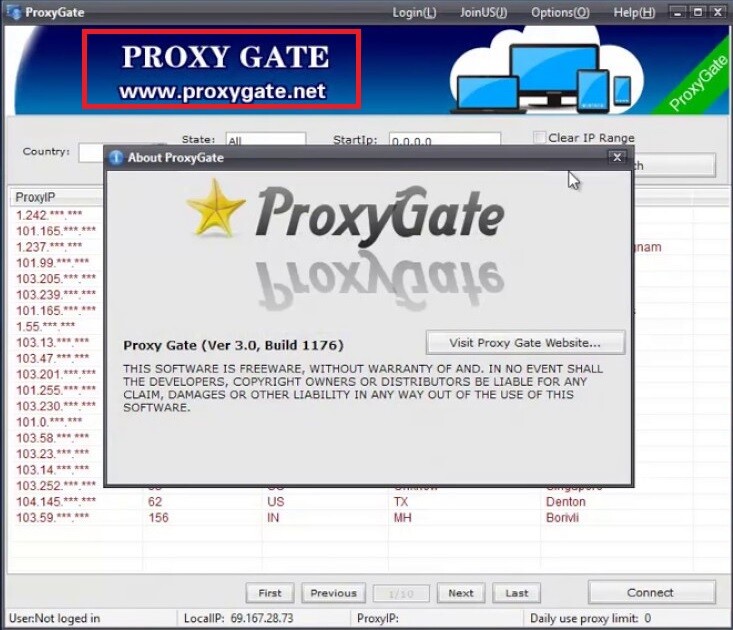ProxyGate
ProxyGate is a piece of software that is capable of incorporating itself in all browsers you may use and cause various undesired changes in their settings and behavior. As a result of these changes, ProxyGate may frequently interrupt your web browsing by aggressive ad-generating activity.

If you want to know what ProxyGate is and how you can uninstall all traces of it from your PC, then you have found the right page. In this removal guide, we are going to explain what has caused the strange changes to your Chrome, Firefox or whatever browser you are using and why you are bombarded with dozens of ads and pop-ups. Most importantly, we will show you an effective way to completely uninstall ProxyGate from your system and safely restore your normal browsing activity, which may now be heavily interrupted by this adware program. For this purpose, we have created an easy-to-follow removal guide below, which will help you uninstall the potentially unwanted program in no time. But before you follow it, we have included some brief information about this software and its typical traits. If you spend a few minutes to read it, you will learn how dangerous adware can be and how to prevent it from getting installed on your computer in the future. So, let’s begin.
You have probably already faced the substituted homepage that is greeting you from the screen or the new search engine that has probably replaced your desirable one and now redirecting all your searches to some pages full with intrusive advertisements, pop-ups, banners and blinking boxes. This is typical behavior, related to a specific software category known as adware, which is often considered by users as potentially unwanted and irritating. Therefore, many of them seek for ways to remove the adware applications from their machines and save themselves from the ads.
Is ProxyGate really a “Virus”?
Many users, who are facing the intrusive ads, pop-ups and banners generated by ProxyGate, may initially think they have been infected with a virus. Luckily, this is a very wrong first impression that this adware gives. And it is mostly because of the rather aggressive way it imposes its changes to the user’s computer and almost immediately starts to bombard them with strange and undesired popping boxes and ads. A real virus, from the rank of Trojans, Ransomware, Spyware and others is very harmful software that aims to compromise your computer, steal your credentials, blackmail you or corrupt your files. All this is illegal, cybercriminal activity, which mostly tries to remain unnoticed on your PC until it completes its bad deeds or gets detected by your antivirus. Adware, on the other hand, is not a virus and cannot be considered malicious. Mostly, it won’t be detected by your antivirus as a threat simply because it does not contain any harmful scripts and does not try to corrupt your system. Moreover, according to the law, adware is legal software that is used by the online advertising industry to generate advertisements and generate profit to its owners through the famous Pay-Per-Click method. That’s why corrupting your computer is neither its aim, nor a thing that a program of this type is capable of.
However, ProxyGate may still cause you some online irritation by constantly exposing you to undesired ads. In fact, this program may turn into a big time-waster that redirects your searches to various web locations and tricks you into interacting with unknown, irrelevant or sometimes even unsafe web content. That’s why, if you are concerned about your system’s safety, it may be a better option to simply uninstall the adware from your machine instead of risking unknowingly bumping into misleading pages with viruses or some worse infections like Ransomware or Trojans.
How to prevent adware in the future?
Adware like ProxyGate is usually distributed via software bundles. This means that when you download different applications from, let’s say, open source download platforms, torrent sites, direct downloads, free software installers or test software offers from spam emails, you are more likely to get such potentially unwanted programs installed along with them. You probably placed ProxyGate on your computer this way. This happens very often during the installation process, where most users don’t read the EULA and quickly click the “OK” button on the standard installation option without checking the bundle in details. And this is a common mistake. A very simple way to prevent any undesired application from getting installed is simply to uncheck it from the menu that will appear only if you click on the “Advanced” or “Custom” option in the setup. Otherwise, you will get it installed without additional notice and removing it later may need some assistance. Luckily, the removal guide below contains all the steps you need to take to fully eliminate ProxyGate, so all you need to do is simply follow them and you will get rid of the annoying ads in no time.
SUMMARY:
Uninstall ProxyGate Virus
You are dealing with a malware infection that can restore itself unless you remove its core files. We are sending you to another page with a removal guide that gets regularly updated. It covers in-depth instructions on how to:
1. Locate and scan malicious processes in your task manager.
2. Identify in your Control panel any programs installed with the malware, and how to remove them. Search Marquis is a high-profile hijacker that gets installed with a lot of malware.
3. How to clean up and reset your browser to its original settings without the malware returning.
You can find the removal guide here.
For mobile devices refer to these guides instead: Android , iPhone

Leave a Reply